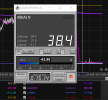Another thing that comes to mind would be one particular issue when it comes to amplification and power demand. I've found a practical example as seen on this video a while ago:
And here it is, the track so heavy on the power demand:
Frequency spectrum:
View attachment 334780
In the video, peaks around 50Hz are already showing high power demand, but to me the waveform with the peak at 34Hz is much more interesting here. On the video, at about 4:28, you may see the woofers on those Harbeths showing some excursion peaks, perhaps they are a bit lower than port tuning.
Here is a zoom in on one of the waveforms (they are a bit different for each passage, also showing difference for the left and right channel, so stereo bass):
View attachment 334783
The point is, if your system has some difficult phase angles between voltage and current demand, I'm sure this track will find it. By the looks of it, I'm not even sure if this should be legal

Subjectively, these low frequency peaks have both weight, because of the low frequency, and impact because of the waveform summation at MLP. But the impact is so slow that it's just passing through my body, either pushing it or pulling it ever so slightly, depending on the waveform of the passage. I find this track a bit weird, but also very clever and unique.
If some of you people having multiple subs care to try it, I would like to hear your thoughts on this.




